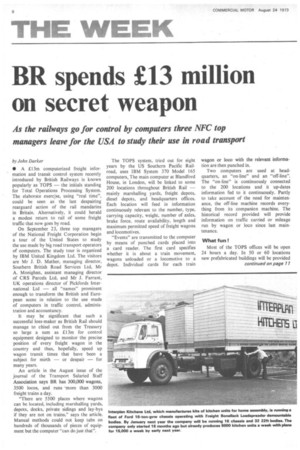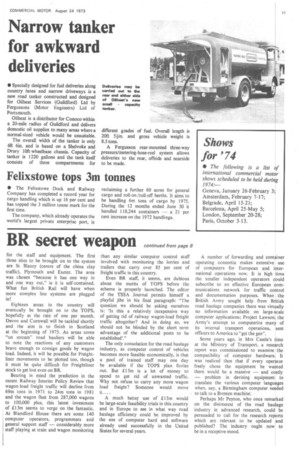BR spends £13 million on secret weapon
Page 10

Page 13

If you've noticed an error in this article please click here to report it so we can fix it.
As the railways go for control by computers three 1VFC top managers leave for the USA to study their use in road transport
by John Darker • A £13m computerized freight information and transit control system recently introduced by British Railways is known popularly as TOPS — the initials standing for Total Operations Processing System. The elaborate exercise, using "real time", could be seen as the last despairing rearguard action of the rail mandarins in Britain. Alternatively, it could herald a modest return to rail of some freight traffic that now goes by road.
On September 23, three top managers of the National Freight Corporation begin a tour of the United States to study the use made by big road transport operators of computers. The study tour is organized by IBM United Kingdom Ltd. The visitors are Mr J. D. Mather, managing director, Southern British Road Services Ltd, Mr A. Monighan, assistant managing director of CRS Parcels Ltd, and Mr J. Farrant, UK operations director of Pickfords International Ltd — all "names" prominent enough to transform the British and European scene in relation to the use made of computers in traffic control, administration and accountancy.
It may be significant that such a successful loss-maker as British Rail should manage to chisel out from the Treasury so large a sum as Ll 3m for control equipment designed to monitor the precise position of every freight wagon in the country and thus, hopefully, speed up wagon transit times that have been a subject for mirth — or despair — for many years.
An article in the August issue of the journal of the Transport Salaried Staff Association says BR has 300,000 wagons, 3500 locos, and runs 'more than 3000 freight trains a day.
"There are 5500 places where wagons can be located, including marshalling yards, depots, docks, private sidings and lay-bys if they are not on trains," says the article. Manual methods could not keep tabs on hundreds of thousands of pieces of equipment but the computer "can do just that".
The TOPS system, tried out for eight years by the US Southern Pacific Railroad, uses IBM System 370 Model 165 computers., The main computer at Blandford House, in London. will be linked to some 200 locations throughout British Rail — mainly marshalling yards, freight depots, diesel depots, and headquarters offices. Each location will feed in information continuously relevant to the number, type, carrying capacity, weight, number of axles, brake force, route availability, length and maximum permitted speed of freight wagons and locomotives.
"Events" are transmitted to the computer by means of punched cards placed into a card reader. The first card specifies whether it is about a train movement, wagons unloaded or a locomotive to a depot. Individual cards for each train
wagon or loco with the relevant information are then punched in.
Two computers are used at headquarters, an "on-line" and an "off-line". The -on-line" is continuously connected to the 200 locations and it up-dates information fed to it continuously. Partly to take account of the need for maintenance, the off-line machine records everything from its companion machine. The historical record provided will provide information on traffic carried or mileage run by wagon or loco since last maintenance.
What fun !
Most of the TOPS offices will be open 24 hours a day. In 50 or 60 locations new prefabricated buildings will be provided continued on page 11
for the staff and equipment. The first three sites to be brought on to the system are St Blazey (centre of the china clay traffic), Plymouth and Exeter. The area was chosen "because it has one way in and one way out," ie it is self-contained. What fun British Rail will have when more complex line systems are plugged in!
Eighteen areas in the country will eventually be brought on to the TOPS, hopefully at the rate of one per month. Devon and Cornwall will be tackled shortly and the aim is to finish in Scotland at the beginning of 1975. As areas come "on stream" road hauliers will be able to note the reactions of any customers brave enough to consign goods by wagon load. Indeed, it will be possible for Freightliner movements to be plotted too, though it must be quite difficult for Freightliner stock to get lost even on BR.
Bearing in mind the prediction in the recent Railway Interim Policy Review that wagon-load freight traffic will decline from 69m tons in 1971 to 24m tons in 1981 and the wagon fleet from 287,000 wagons to 100,000 plus, this latest investment of £13m seems to verge on the fantastic. At Blandford House there are some 140 computer operators, programmers and general support staff — considerably more staff playing at train and wagon monitoring than any similar computer control staff involved with monitoring the lorries and trailers that carry over 85 per cent of freight traffic in this country.
Even BR staff, it seems, are dubious about the merits of TOPS before the scheme is properly launched. The editor of the TSSA Journal permits himself a playful jibe in his final paragraph: "The question we should be asking ourselves is: 'Is this a relatively inexpensive way of getting rid of railway wagon-load freight traffic altogether? And in doing so, we should not be blinded by the short term advantage of the additional posts to be established'."
The only consolation for the road haulage industry, as computer control of vehicles becomes more feasible economically, is that a pool of trained staff may one day be available if the TOPS plan fizzles out. But £13m is a lot of money to spend to get rid of unwanted traffic. Why not refuse to carry any more wagon load freight? Someone would move A much better use of £13m would be large-scale feasibility trials in this country and in Europe to see in what way road haulage efficiency could be improved by the use of computer hard and software already used successfully in the United States for several years. A number of forwarding and container operating consortia makes extensive use of computers for European and international operations now. It is high time the smaller independent operators could subscribe to an effective European communications network for traffic control and documentation purposes. When the British Army sought help from British road haulage companies there was virtually no information available on large-scale computer applications: Project Lawson, the Army's attempt to computerize many of its internal transport operations, sent officers to America to "get the gen".
Some years ago. in Mrs Castle's time at the Ministry of Transport, a research report was commissioned to examine the compatibility of computer hardware. It was realized then that if every operator freely chose the equipment he wanted there would be a massive — and costly — problem in devising equipment to translate the various computer languages when, say, a Birmingham computer needed to talk to a Bremen machine.
Perhaps Mr Peyton, who once remarked on the disinterest of the road haulage industry in advanced research, could be persuaded to call for the research reports which are relevant to be updated and published? The industry ought now to be in a receptive mood.




















































































